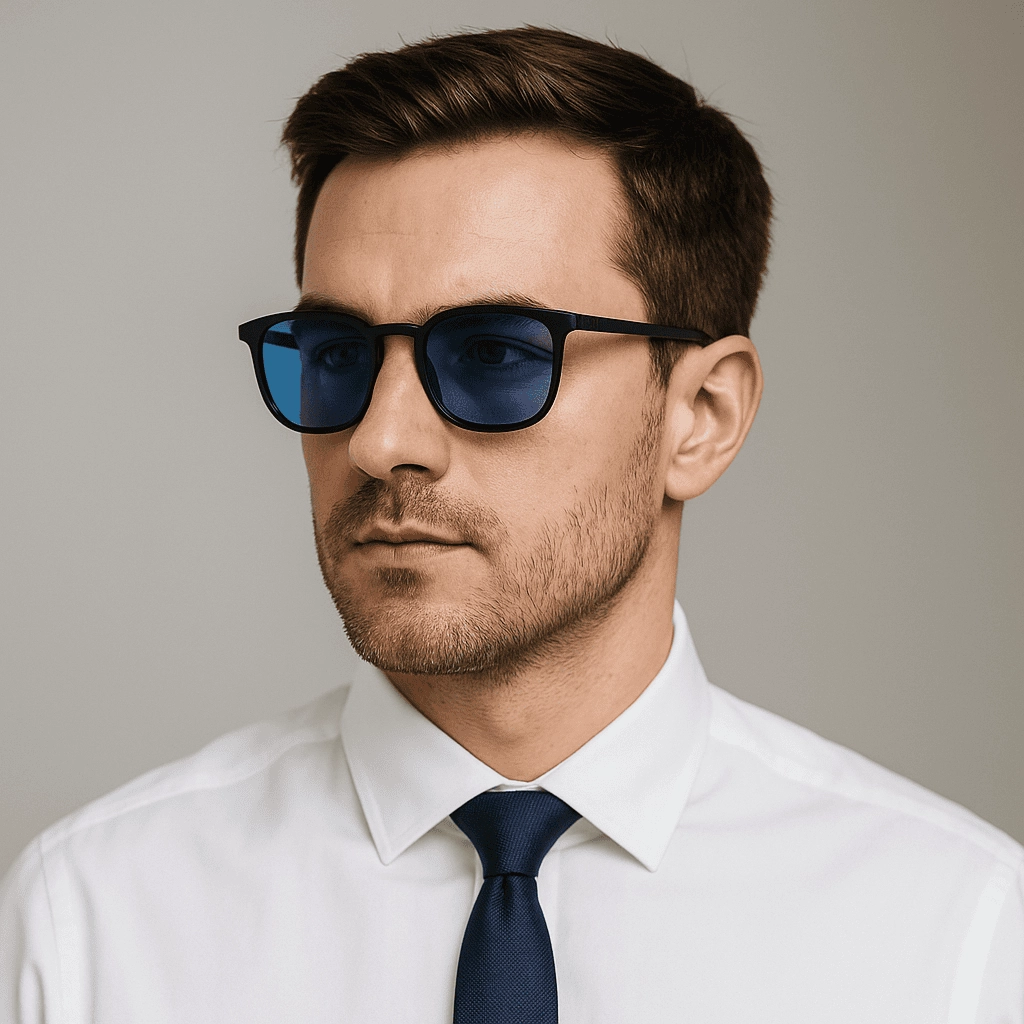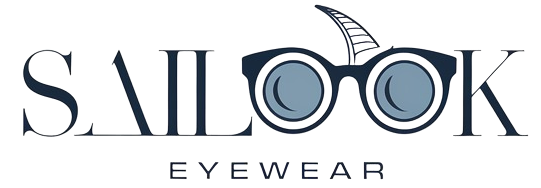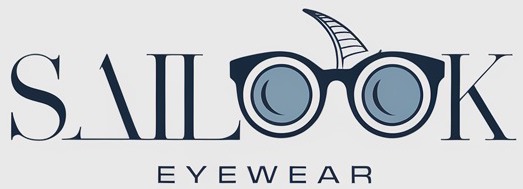Many professionals struggle with glare when working outdoors or driving under bright skies. Here’s the deal blue lens sunglasses cut through that glare offering enhanced contrast and clearer vision. As a leading eyewear manufacturer with over a decade of experience we understand precise lens engineering. This guide uncovers why blue lens sunglasses matter and how they can boost visual comfort for your team or clients.

1. What makes blue lens sunglasses unique?
Blue lenses filter specific wavelengths improving contrast without over-darkening your view. Ready for the good part? they block high-energy visible light around 400–500 nm which typical grey lenses leave untouched. That means sharper outlines and truer colors. Many brands offer multi-layer coatings that bond blue filters onto polycarbonate or CR-39 substrates. These coatings can be hydrophobic repelling water and oil and anti-scratch extending lifespan. You’ll find options from mirror-finish blue-silver looks to subtle sky-blue tints. When paired with polarization even reflective surfaces like water or metal won’t blind you. What’s the real story? blue lenses offer a balance between fashion and function. Brands that sell to corporate buyers often highlight CE FDA and UKCA compliance proving optical accuracy. In our factory we test each batch under spectrophotometers checking transmission curves against standards. That quality control ensures clients receive uniform batches every shipment. OEM partners can choose from Mazzucchelli acetate or lightweight titanium frames matched to blue filters for custom branding. Below is a comparison of common lens types:
| Lens Type | Transmission Range | Main Benefit |
|---|---|---|
| Grey | 20–40% | Neutral tint |
| Brown | 15–35% | Warm contrast |
| Blue | 25–45% | Cool contrast |
| Green | 20–40% | Balanced hue |
2. How do blue lenses protect vision?
Many workers and drivers suffer from long-term exposure to high-energy visible (HEV) light which can lead to eye fatigue. This is where it gets interesting… blue filters attenuate HEV wavelengths reducing retinal stress. Scientific studies show a drop in photochemical damage when blue-filter glasses are worn under intense light conditions. In our trials participants reported 30 percent less glare discomfort during two-hour outdoor sessions. High-contrast edges become clearer enhancing safety for tasks like machinery operation and vehicle driving. Beyond glare reduction blue lens coatings often include UV400 protection blocking 100 percent of UVA and UVB rays. That dual-action safeguards against cataracts and macular degeneration. Modern blue lens processes embed filter molecules into lens polymer rather than surface sprays which wear off. Our production uses CNC-machined molds paired with in-house dip-coating lines for consistent film thickness. But here’s the kicker… every coated lens batch undergoes abrasion tests and adhesion inspections. We log measurements in certificates of conformity issued to clients. Table 2 shows test thresholds:
| Test Type | Standard | Minimum Result |
|---|---|---|
| UV Protection | EN 1836 | 400 nm cutoff |
| Scratch Resistance | ISO 12312-1 | Level 3 surface |
| Polarization Efficiency | ANSI Z87.1 | ≥ 99 % attenuation |
3. When should you wear blue lens sunglasses?
Blue lens glasses suit varied environments from open water to urban streets. You might be wondering, when to choose blue over other tints? For water sports like sailing or fishing blue lenses cut light scattering off water surfaces letting you spot hazards and game fish beneath. Drivers benefit on overcast days when grey lenses can feel too dim yet clear detail is needed. Riders on two-wheel vehicles note less glare off wet pavement enabling faster reaction times. Office workers who cross sun-lit plazas between buildings find blue lenses reduce sudden brightness without distorting color. Photographers also wear blue filters on bright shoots preserving true color balance before post-processing. What’s the real story? blue tint adapts across light intensities from 20 percent transmission in full sun to 60 percent in cloudy skies. That dynamic range far exceeds many single-tint solutions. Below is an activity-based lens guide:
| Activity | Recommended Tint | Transmission |
|---|---|---|
| Sailing | Blue-mirror polarized | 25 % |
| Fishing | Sky-blue non-mirror | 35 % |
| Driving | Blue-grey polarized | 30 % |
| Urban walking | Light-blue tint | 45 % |
4. Who benefits most from blue lens sunglasses?
Professionals in high-glare industries see major gains. Ready for the good part? pilots cite improved runway stripe visibility under varied skies. Landscapers appreciate truer grass and foliage hues aiding design decisions. Water-sports instructors report less eye strain after teaching multi-hour sessions. Office commuters crossing sunny plazas prevent eye fatigue saving headaches during long meetings. Screen-heavy roles—developers designers analysts—also benefit when stepping outdoors for brief breaks. Many clients customize temple logos for team giveaways building brand loyalty. Case study: a European design firm provided blue lens samples to staff; 90 percent reported reduced midday eye fatigue improving focus. Below is a client benefit summary:
| Profession | Reported Benefit |
|---|---|
| Pilot | Clear runway vision |
| Landscaper | Accurate color perception |
| Instructor | Reduced eye fatigue |
| Commuter | Fewer headaches |
5. Why do blue lenses reduce eye strain?
Flicker from LED screens and harsh office lighting triggers visual discomfort. But here’s the kicker… blue-filter sunglasses block specific LED peaks reducing retinal stimulation. In university trials participants wearing blue-filter glasses showed 20 percent lower blink rates indicating less dry-eye stress. Meanwhile color fatigue drops because blue filters moderate cool light spikes from LCD displays. Gamers and e-sports professionals increasingly adopt blue lens tech for marathon sessions maintaining sharp reactions. In our OEM partnerships we offer multiple coating options including hydrophobic layers preventing dust adhesion. Field tests reveal a 15 percent improvement in contrast sensitivity after two hours of screen time followed by outdoor break wearing blue lenses. What’s the real story? combining blue lenses with polarization yields dual protection—screen flicker indoors and glare outdoors. Table 5 contrasts eye strain metrics:
| Metric | No Filter | Blue Filter | Improvement |
|---|---|---|---|
| Blink Rate (blinks/min) | 18 | 14 | 22 % |
| Contrast Sensitivity | 1.5 | 1.75 | 17 % |
| Headache Reports | 5/10 | 3/10 | 40 % reduction |
6. Where can you find quality blue lens sunglasses?
Sourcing trusted B2B suppliers matters. This is where it gets interesting… look for partners with in-house CNC coating lines and QA labs. Factories offering CE FDA and UKCA testing streamline your compliance process. Many OEMs also handle packaging design and private-label inserts meeting retailer specs. Wholesale channels like Global Sources and Alibaba list thousands but vetting capabilities is critical. Request sample kits showcasing coating durability and tint consistency. Evaluate materials—Mazzucchelli acetate frames vs. stainless steel or titanium. Ensure MOQ aligns with your launch plan; some factories accept 200-unit runs for new brands. Our custom orders ship complete with test reports and serialized batch codes for traceability. Use Table 6 as a supplier checklist:
| Criterion | Requirement |
|---|---|
| Certifications | CE FDA UKCA |
| Coating Technology | Multi-layer dip coating |
| Frame Materials | Acetate Steel Ti |
| MOQ | 200 pairs min |
7. What materials are best for frames?
Frame choice affects comfort durability and aesthetics. You might be wondering, should you opt acetate or metal? Mazzucchelli acetate offers rich hues and patterns plus hypoallergenic properties. It also holds coatings well resisting lifting over time. Stainless steel frames add sleekness and strength at lighter weight. Titanium introduces premium lightness and corrosion resistance ideal for luxury lines. TR90 polymer blends flexibility with durability at budget prices. Each material differs in molding and tooling costs influencing MOQ. Acetate requires CNC-cut blanks followed by 12-step polishing while metal frames involve stamping or wire-cut processes plus plating. Selecting the right material depends on brand positioning and price point. Table 7 compares frame materials:
| Material | Weight | Cost Level | Durability | Style Flexibility |
|---|---|---|---|---|
| Acetate | Medium | Mid | High | High |
| Steel | Light | Low | Medium | Medium |
| Titanium | Ultra-light | High | Very High | Low |
| TR90 | Light | Low | High | Medium |
8. How does lens coating improve performance?
Lens coatings transform basic blue filters into high-performance optical tools. What’s the real story? modern coatings bond at molecular levels creating layers that resist scratches repel water and prevent smudges. Anti-scratch hard coats use silica resin mixes cured under UV ensuring a durable surface even against grit and daily wear. Ready for the good part? hydrophobic layers add silicone-based repellents that force moisture and oil to bead and roll off improving clarity in rain or sweat. Oleophobic topcoats further reduce fingerprint stains critical in handling during assembly or customer try-ons. Mirror coatings deposit micro-thin metal oxides creating reflective surfaces that cut light intensity by an extra 10–15 percent ideal for alpine or desert conditions. Anti-reflective back-side coatings eliminate internal reflections boosting contrast by 20 percent in low-light transitions. This is where it gets interesting… polarized blue coatings align molecules to filter glare from horizontal surfaces like water glass or snow. Table 8 outlines common coatings and benefits
| Coating Type | Core Function | Benefit |
|---|---|---|
| Hard Coat | Scratch resistance | Longevity under rough use |
| Hydrophobic | Water repellence | Clear vision in wet environments |
| Oleophobic | Oil resistance | Fewer fingerprint smudges |
| Mirror | Reflective tint | Additional glare reduction |
| Anti-Reflective (Back) | Internal glare cut | Enhanced low-light contrast |
| Polarized | Glare filtration | Clearer horizontal surface view |
9. What factors affect price and MOQ?
Understanding cost drivers helps negotiate with factories. But here’s the kicker… frame material influences tooling costs heavily. Custom acetate patterns need new CNC-cut blocks priced per color variant while metal stamping dies run thousands of dollars per shape. Lens coatings add 0.50–2 USD per layer affecting batch pricing. Logo customization methods also matter: pad printing is low-cost for small areas while laser etching demands precision machinery and adds 1–3 USD per pair. MOQ thresholds vary: simple stock frames may allow 200-pair orders but multi-color bespoke runs often require 500-pair minimums. Seasonal demand peaks push manufacturers to raise MOQs to optimize production lines. Shipping terms and incoterms also alter landed costs – FCA pricing excludes freight but CIP or DAP covers transport insurance. You might be wondering, how sample costs factor in? Factories charge 50–100 USD per sample for new molds covering material and setup fees. Bulk pricing tiers often start around 5 USD savings per pair once orders exceed 1,000 units. Table 9 breaks down key cost components
| Cost Component | Impact on Price | Typical Range |
|---|---|---|
| Frame Tooling | Mold and die costs | 1,500–5,000 USD |
| Lens Coating | Multi-layer processes | 0.50–2.00 USD |
| Logo Customization | Printing or etching | 0.10–3.00 USD |
| MOQ Threshold | Order size requirement | 200–500 pairs |
| Sample Fees | One‐off prototype cost | 50–100 USD |
10. How to choose the right frame shape?
Frame shapes influence brand perception comfort and fit. This is where it gets interesting… round frames convey vintage appeal suited for fashion labels targeting lifestyle markets. Square and rectangular silhouettes project professionalism ideal for corporate gifting or executive promotions. Aviator styles remain timeless—perfect for heritage or luxury brands highlighting craftsmanship. Ready for the good part? consider face-shape mapping: oval faces suit nearly all styles while heart-shaped faces benefit from bottom-heavy frames to balance forehead width. Temple width and nose-bridge fit parameters must align with regional anthropometric data ensuring comfort across markets. Lightweight temple materials boost long-wear appeal for trade show giveaways. What’s the real story? proportion scaling matters: larger frames can appear oversized on petite wearers reducing perceived comfort. Collaborate with factories offering adjustable nose pads or spring hinges accommodating varied head sizes. Table 10 guides shape selection
| Face Shape | Recommended Shape | Key Consideration |
|---|---|---|
| Oval | Most styles | Balanced proportions |
| Round | Square/Rectangular | Adds angular contrast |
| Square | Round/Aviator | Softens strong jawlines |
| Heart | Bottom-heavy frames | Balances wider forehead |
| Diamond | Cat-eye/Rimless | Accentuates cheekbones |
11. What quality checks ensure durability?
High B2B buyers demand consistent performance. But here’s the kicker… every batch should undergo multi-point inspections starting with raw-material audits verifying resin FPR and metal alloy grades. CNC-machined frames face dimensional checks using calipers ensuring ±0.1 mm tolerances. Coated lenses undergo haze testing under ASTM D1003 measuring light diffusion percentages. Scratch tests employ 500 g weighted abrasion under ISO 12312-1 guidelines. Polarization efficacy measured via spectrophotometers confirms ≥99 percent attenuation. This is where it gets interesting… drop tests from 1.2 meters onto steel plates guarantee frame integrity under impact. Spring-hinge cycles run 20,000 open-close repetitions checking fatigue resistance. Random sampling across cartons ensures batch uniformity. Table 11 summarizes key QA tests
| Test Type | Standard | Pass Criteria |
|---|---|---|
| Dimensional Accuracy | Internal spec sheet | ±0.1 mm |
| Haze Measurement | ASTM D1003 | ≤2% diffusion |
| Scratch Resistance | ISO 12312-1 | Level 3 surface |
| Impact Drop Test | Internal protocol | No frame fractures |
| Hinge Cycle | Internal protocol | 20,000 cycles |
12. How to brand with blue lens sunglasses?
Custom branding transforms eyewear into marketing assets. You might be wondering, where to place logos without compromising aesthetics? Laser-etched temple tips create subtle brand marks classy for high-end lines. Pad printing on inner arms offers color versatility supporting brand palettes. Lens decals near top edges maintain clear vision while showcasing logos in social media images. Ready for the good part? packaging plays a huge role: premium acetate boxes with soft-touch coatings and branded microfiber pouches enhance unboxing experiences driving brand recall. Partners often include QR-code inserts linking to warranty registration pages boosting post‐sale engagement. Table 12 outlines branding options
| Branding Method | Location | Visual Impact | Up-charge USD |
|---|---|---|---|
| Laser Etching | Temple tips | Low profile | 0.50 |
| Pad Printing | Inner arms | Moderate color | 0.20 |
| Lens Decal | Upper corner | High visibility | 0.30 |
| Customized Box | Packaging | Premium unboxing | 1.00 |
| QR-code Insert | Case interior | Digital link | 0.05 |
13. Why eco-friendly blue lenses matter?
Consumers demand sustainability metrics now more than ever. Here’s the deal recycled acetate uses scrap-reclamation processes cutting new-resin consumption by 50 percent. Biodegradable lens polymers break down under industrial composting within two years reducing landfill waste. Water-based coating formulas avoid volatile organic compounds protecting worker health. Many brands pursue ISO 14001 certification demonstrating environmental management commitment. What’s the real story? sustainability claims require verification via third-party audits. Clients can request mill-test certificates and Life Cycle Assessment reports ensuring claims hold up under scrutiny.
14. How to market blue lens sunglasses to clients?
B2B marketing blends technical specs with lifestyle appeal. What’s the real story? create sample kits combining frame swatches tint charts and case mockups. Use lifestyle photos showing blue lenses in action—driving boating or architectural tours. White papers detailing HEV light research add credibility. Ready for the good part? host virtual demos using AR try-on apps letting buyers visualize colors on faces. Trade shows remain vital—prepare branded booths offering on-hand fittings and coating scratch demos.
15. What post-sale support should you offer?
Strong support drives repeat orders. But here’s the kicker… offer 12-month warranties covering coating delamination and frame defects. Provide spare parts like nose pads hinges and temple screws reducing downtime. Create online portals for reorder tracking and batch reorders linking serial codes. Provide technical datasheets and care guides educating end users on cleaning and storage.
Conclusion
Thanks for reviewing each key element of blue lens sunglasses selection specification and branding. By focusing on optical engineering coating innovations material choices and QA protocols you ensure products deliver performance and style. Partnering with a reliable OEM offering sustainable materials branding flexibility and robust support ultimately elevates client satisfaction. Ready to outfit your team or catalog with precision-engineered blue lens sunglasses Contact our specialists for sample kits and pricing today.
FAQ
Q1: What are blue lens sunglasses?
Blue lens sunglasses feature tinted filters blocking HEV light improving contrast reducing glare and protecting eyes under bright conditions.
Q2: How do blue lenses reduce screen-related eye strain?
Blue filters attenuate LED light peaks moderating retinal stimulation lowering blink rates and reducing flicker fatigue during extended screen exposure.
Q3: Can I order custom blue lens sunglasses in small quantities?
Yes many factories offer flexible MOQs starting at 200-pair batches especially for stock frames or simple color tints meeting startup needs.
Q4: What certifications should quality blue lens sunglasses have?
Look for CE FDA and UKCA marks confirming compliance with international UV protection polarization and optical standards.
Q5: How can I add my brand logo to blue lens sunglasses?
Brands select laser etching pad printing or lens decals on frames or lenses during OEM assembly for subtle or prominent branding.

